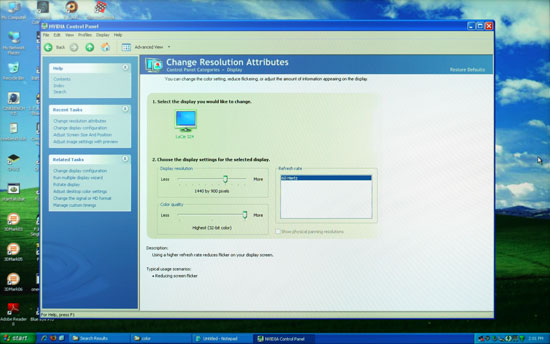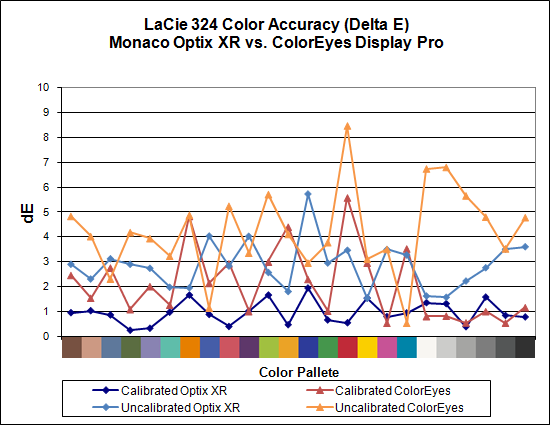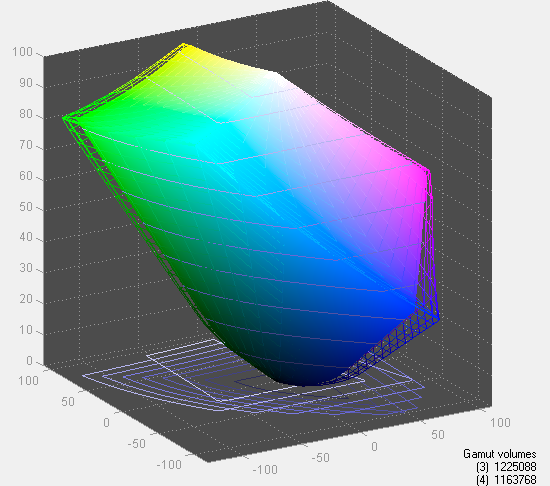LaCie 324 Evaluation
At first blush, the LaCie 324 OSD seems more limited than the options on other LCDs. There are only three main screens, one of which is for PIP. The other two screens are full of useful adjustments, however. LaCie also uses touch-sensitive buttons, and we periodically encountered difficulty with activating the "down" button (i.e. we would press it, move our finger around, etc. all to no avail; exiting the menu and returning would usually correct the problem). We would have preferred tactile feedback, but the overall result wasn't quite as finicky as the Samsung buttons, in part because the six buttons have white labels that are clearly visible.
LaCie provides six color presets, five color temperature settings, and five gamma levels. The last should be of particular interest to those involved with desktop publishing, where the ability to switch between 1.8 and 2.2 gamma can be useful. The 324 also has an "Over Speed" option that is supposed to improve pixel response times. Again, we didn't notice any serious issues with pixel response, but unfortunately the "over speed" mode does not address input lag.
| LaCie 324 Resolution and Input Notes | |||
| DVI | HDMI | VGA | |
| 800x600 | Yes | Wrong AR; Stretches horizontally to fill LCD | Yes |
| 1024x768 | Yes | Wrong AR; Stretches horizontally to fill LCD | Yes |
| 1152x864 | Yes | Wrong AR; Stretches horizontally to fill LCD | - |
| 1176x664 | Poor scaling artifacts | Underscanned 720P | - |
| 1280x720 | Poor scaling artifacts | Yes | Yes |
| 1280x768 | - | - | Sets 1280x800 and clips top and bottom |
| 1280x800 | Wrong AR (1280x960) | Wrong AR; Stretches horizontally to fill LCD | Yes |
| 1280x960 | Yes | Wrong AR; Stretches horizontally to fill LCD | Yes |
| 1280x1024 | Yes | Wrong AR; Stretches horizontally to fill LCD | Yes |
| 1400x1050 | - | Wrong AR; Stretches horizontally to fill LCD | - |
| 1440x900 | Yes | Wrong AR; Stretches horizontally to fill LCD | Yes |
| 1600x1200 | Yes | Wrong AR; Stretches horizontally to fill LCD | Yes |
| 1680x1050 | Always has top/bottom black borders | Wrong AR; Stretches horizontally to fill LCD | Yes |
| 1768x992 | - | Underscanned 1080P | - |
| 1920x1080 | Interference/Static Present; Always has top/bottom black borders | Yes | Clips output to 1680x1050 |
| 1920x1200 | Yes | - | Yes |
There are four scaling options: Real, Smart Zoom, Zoom, and Dx2D. "Real" is the same as what other LCD manufacturers call "1:1". "Smart Zoom" stretches whatever resolution you are running to fill the LCD while maintaining the correct aspect ratio, and "Zoom" fills the entire LCD. We're not at all sure what the "Dx2D" is supposed to do; sometimes it looks the same as "Smart Zoom" and other times it looks like "Real", though in a few cases using it instead of one of the other scaling options will result in fewer scaling artifacts.
For the inputs, HDMI only works properly with 720P/1080P resolutions and should be avoided for most other resolutions if possible; otherwise you get a horizontally stretched image with black borders on the top and bottom. VGA connections work properly except for a couple resolutions, while DVI has scaling errors on several resolutions, including the frequently used 1680x1050. It also seemed as though the VGA input showed more signal interference than on other LCDs, but the cable we were using may have been to blame.
 |
Scaling on the LaCie 324 looks good when it works properly, as seen here. Just do your best to avoid the problem resolutions/inputs listed in the chart above.


Considering this is a professional LCD, we were definitely interested in seeing what sort of color accuracy LaCie could achieve. If we had looked at the 324 before receiving some of the other monitors, the uncalibrated color accuracy would have been very impressive. As it stands, LaCie does well but professionals will still want to use calibration hardware and software. Color gamut is also good, coming in at 95%.
The question on our minds while reviewing the LaCie 324 is what exactly do users get for the extra ~50% price increase relative to the competition? We can say quite easily that we are not the target market, despite the fact that we do plenty of online publishing. For most users, 10-bit gamma correction and color lookup tables just aren't going to make that big of a difference. After all, Dell manages to achieve better color accuracy according to our measurements. However, the selection of gamma, temperature, and color options within the OSD will likely benefit certain users.
If you have a regular need to work at 1.6 gamma to 2.4 gamma, the LaCie may in fact be the better choice. The 10-bit gamma helps to provide better gradients without banding. Perhaps more important is the warranty that LaCie provides. A 3-year warranty isn't any better than what many of the other companies provide, but an advance replacement policy to minimize downtime is noteworthy. LaCie also sells a bundled package consisting of the 324 LCD with their blue eye pro software and colorimeter, and they state that the software is tuned for their hardware. Finally, LaCie is committed to using the same wide color gamut S-PVA panel on all 324 LCDs, so you won't find different versions with different panels. They test for color uniformity and only use panels that pass their testing, eliminating lower grade panels.
As a whole package, LaCie is clearly targeting professional users, from the LCD and warranty to their blue eye pro software and colorimeter. We did run some initial tests with blue eye pro, and one aspect that is definitely better than competing solutions is that the software and hardware worked under Vista 64-bit -- something we can't say of ColorEyes Display Pro or Optix XR Pro. There were some periodic pauses when we tried to use blue eye pro under 64-bit Vista, but it did successfully calibrate our test monitor.
Given the online price of $900 or more, we are more inclined to stick with one of the LCD alternatives. After all, $900 will get you pretty much any other 24" LCD plus appropriate calibration equipment -- sometimes with change left over. However, there's a reason LaCie is viewed as a professional solution and if that's your line of work, the extra cost should be easy to stomach as a long-term investment.
















89 Comments
View All Comments
JarredWalton - Tuesday, May 6, 2008 - link
But that's exactly what I did in this review. Unless you mean a high-speed video camera that can record the changes in response to external stimuli (i.e. someone clicking a mouse).I think way too many people are losing sight of the forest because they're obsessing over the trees. I've given relative input lag, and it's accurate to 10ms for sure (and with averaging it should be accurate to around 3ms). At some point I may find an LCD that has a negative lag relative to the HP LP3065, and that's fine. As it stands, the best LCDs equal that LCD's lag.
Input lag as a whole is only one consideration of a display purchase, and differences of 3ms (or even 10ms) are not going to make you suddenly superior in games. 50ms? Sure, that's a potential problem, but anyone who has played online FPS games competitively knows that you have to learn to anticipate in order to compensate for network lag that may be anywhere from 50 to 150ms even with a high-speed connection.
If you want a display that offers minimal processing lag, so far the TN panels and 30" LCDs do great. I'd assume all the 22" LCDs do reasonably well, but having none in house at present I can't say for sure. Then everyone with S-PVA panels can call you an LPB.
jmunjr - Friday, May 2, 2008 - link
Though there are reports it now uses a TN panel, I am disappointed the Soyo Topaz S was not in this review. A bare bones S-PVA monitor for as low as $250 and easily $300 with no rebates? Ring me up! I have one and for the price it cannot be beat - period. At 24" TN monitors have too many shortcomings.bupkus - Friday, May 2, 2008 - link
I read this article this morning and then my gf calls me an tells me she has a $100 Dell credit that expires tonight.I thought, why not sell my Samsung SyncMaster 225BW and get this UltraSharp 2408? Starting Price... $679.00, that's why.
However, the E248WFP is on sale for $379.00. How does that compare?
Dashel - Friday, May 2, 2008 - link
Count me among those who want to know if it's even possible a revision will address the input lag on the Dell 2408. That's all that is holding me back from buying this monitor.Can they even get it down to 2407 input lag levels?
Finally BenQ G2400W, see if they wont give you one to review! That's my back up plan if the Dell doesnt pan out ;)
JarredWalton - Friday, May 2, 2008 - link
The best S-PVA panel has a 20ms lag on average. Note also that the Gateway FPD2485W uses a Faroudja chip and ends up with 20ms while the TN FHD2400 uses a Faroudja and gets ~0ms and LaCie does the same and gets 40ms. My guess is that somehow in the interest of colors or something else the S-PVA tech is delaying what you see on the LCD. The built-in scalers may also be inducing some delay, but the TN panels have scalers as well and don't suffer from any lag.Dashel - Saturday, May 3, 2008 - link
Isnt the 2407 an S-PVA as well though? You'd think they'd be able to at least match that level of input lag. That'd be enough to make me confident enough to buy one.As it stands, I'll have to see what revision A01 brings. I'll probably get one anyway. No 24" seems to have everything I want sadly. Good gaming non TN panel with plenty of inputs. The 2408 or that DoubleSight seems to come closest.
GTVic - Friday, May 2, 2008 - link
I would like to know if it is possible for game developers or hw manufacturers to develop controls in the games or in the driver control panel that would allow an adjustment for input lag. That way if you know you have a certain lag you can tell the game/driver to compensate.PPalmgren - Friday, May 2, 2008 - link
I highly doubt this would be possible.When I first hooked up my NEC 2470WNX, I played some DotA in (a Warcraft 3 map) and noticed after 5 minutes that I couldn't click on anything as well as usual. The funny thing is this isn't really aim-intensive, being an FPS. I tested it out and realized my mouse's response was delayed on the screen. I then noticed the same problem playing BF2 and NS a day later. It becomes impossible to aim quickly because you aim based on where your cursor is visible. However, your cursor is not where you see it on the screen, its still moving. Its a constant fight of over-compensation ruins your gameplay. The next week, I put my old Viewsonic 19' back up and still use it for games. I STRONGY suggest buying a TN panel for games, having experienced the short end of the stick.
GTVic - Friday, May 2, 2008 - link
I think it certainly should be possible.There a maybe a few types of lag. One is due to an overloaded graphics card that is not able to draw enough frames per second to properly update your mouse position so you don't know what you are shooting at. There is nothing to be done about that except buy a better graphics card or reduce the resolution/quality.
The other type of lag is when the game thinks one frame is being displayed and due to delays down the chain an older frame is being displayed. The game records your mouse click (gun fire) and calculates whether you hit the target based on the wrong frame.
The lag is not enough to cause the audio to be out of sync but if the game knew that the display was constantly 3 frames behind then it should be possible to correct the problem. Would be nice if Jared could investigate that with ATI/nVidia/game devs.
Dainas - Friday, May 2, 2008 - link
Oh you don't have to go to TN, I have two 24" P-MVAs that suffer from none of the blatant lag in the aforementioned panels. Both are verifiably faster than the 20ms 2407wfp and coming from a CRT I had none of the loose feeling in fast FPS like CS:Source and CoD4. All these slow panels are more in the realm of 40ms.need only look at this to know TNs do not have an unavoidable technical advantage over VA panels and its likely the manufactures putting IQ over response in most cases ;
http://www.digitalversus.com/article-357-3215-303....">http://www.digitalversus.com/article-357-3215-303....
But then again considering these panels are dissapearing from the market one might have to go TN afterall for gaming.